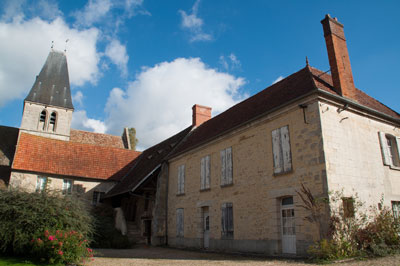
Sentiers du Patrimoine ®
Genainville

Afin de profiter de la promenade du Val, aller jusqu’au restaurant puis prendre à droite et la première à droite. Suivre la promenade jusqu’à revenir sur la place de l’Eglise. Prendre à gauche, puis, la première à gauche jusqu’au lavoir de la rue Serée.
Lavoir de la rue Serée
Prochain point : lat="49.1262579999869" lon="1.753184"

In 658, Queen Bathilde, wife of Clovis II, ceded the land to the Jumièges Abbey, who founded a priory on it. In 1575, the Bourbon-lèz-Gaillon Charterhouse, a religious institution in Eure, came into possession of the priory, retaining it until the revolution. Then Saint-Pierre priory was the headquarters of a large agricultural domain, whose land was sold as a national asset around 1790.
The architectural complex was built around a central, square-plan courtyard. At the entry to the farm were two separate round-arched arcades supported by buttresses, one for carriages and the other for pedestrians. This gateway was demolished in June 1892. The manorial lodgings, where the monks and the prior lived, were located in the section perpendicular to the church. The roof, overhung with flat tiles, covers the staircase and a landing with a round-arch Roman door, its voussoirs (arch stones) decorated with geometric patterns. The door and a gemel window (a window divided into two equal parts by a small column) dating from the 13th century have been listed as historical monuments since 4 June 1926.
In the 18th century, the priory was made up of a dovecote, a tithe barn, an L-shaped manorial lodging, several barns, stables, sheep sheds and a cereal silo, now long gone. The dovecote, dating back to 1577, is located in the centre of the courtyard.
Cylindrical in shape, it is seven metres high and 6.5 metres in diameter. Built in rubble stones and sandstone, the ground floor was used as a cellar while the first floor was home to the birds. In its centre, a wooden rotating ladder provided access to the boulins (the name given to the nesting boxes).
The priory was transformed into a farm in the 19th century, and would remain in operation until the mid-20th century.

